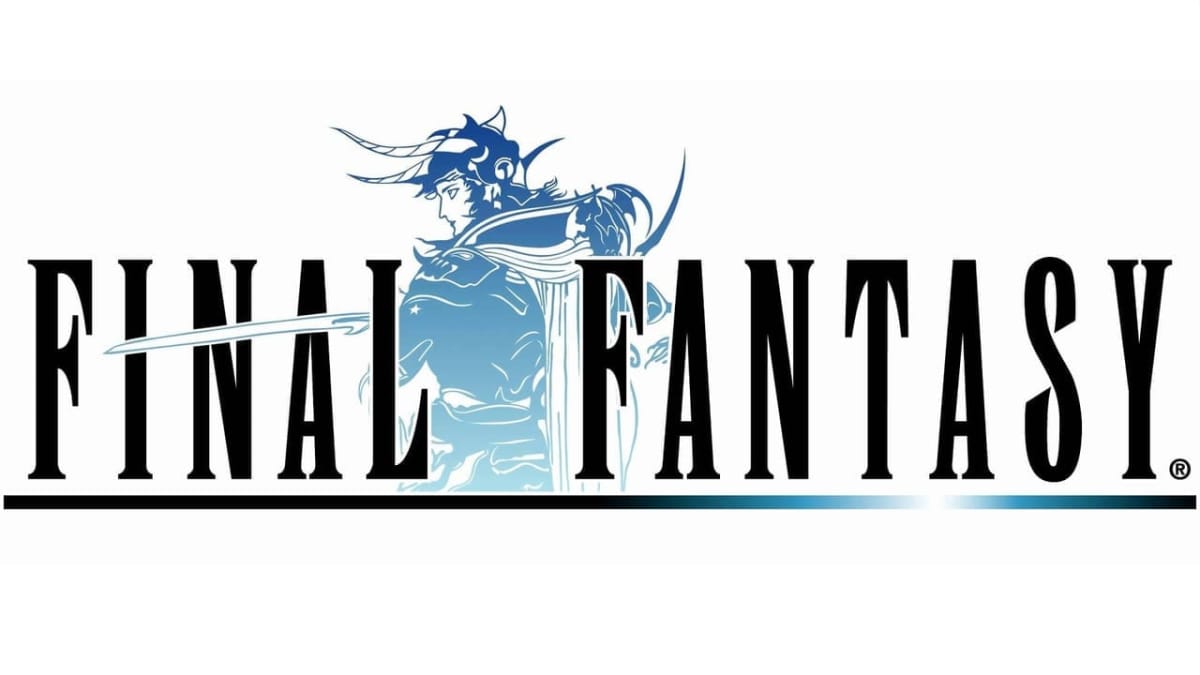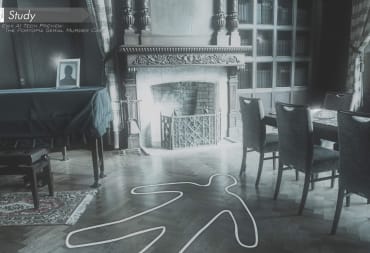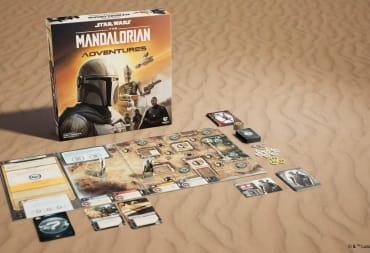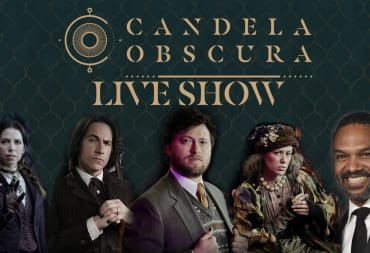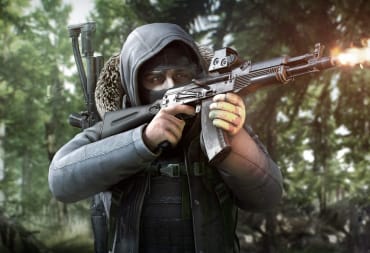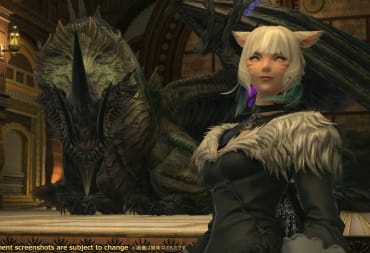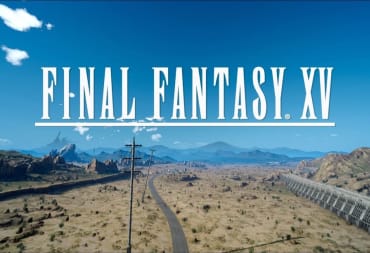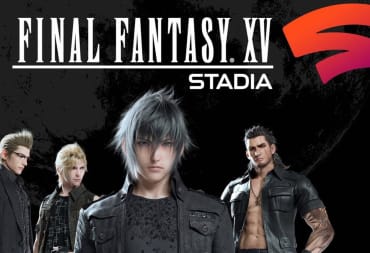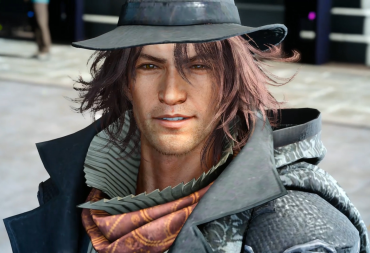Each genre has its own poster child series. Platformers have Super Mario Bros., FPS games have Call of Duty, and strategy games have Civilization. For RPGs, it's safe to say that Final Fantasy is the most recognizable in the genre. It's been around for many years, more than I've even been alive. In fact, it's almost exactly 30 years old.
We just passed December 18th, 2016 and 29 years prior to that date, the original Final Fantasy released to Japanese audiences. The story is an infamous one by now: After a string of poorly-selling games, young Squaresoft was on the verge of bankruptcy. Programmer Hironobu Sakaguchi wanted to make one more title for the company with the last of its funds. If it failed, he would go back to university and leave the gaming industry forever.
So, taking inspiration from RPGs like Dungeons & Dragons and Wizardry, Sakaguchi went about with his seven coworkers to make the final game from Squaresoft, a fantasy-based RPG.

Since you’re reading this today, I’m sure you can guess how the game turned out. A smashing worldwide success, Final Fantasy saved the company and helped set them back on track to become the powerhouse they are today. In fact, they just released Final Fantasy XV last month!
Now, Square Enix has teased information about the upcoming 30th anniversary for the series. To be honest, I saw the announcement about the event in January and a thought popped into my head. I love Final Fantasy. It’s by far one of my favorite series of all time, and I thought that I should partake the coming celebration! So, in a flash of about 15 minutes, I came up with a roadmap of celebration.
Starting this month with the first Final Fantasy, I will go through a main non-MMO title each month and do an in-depth look at it. Setting aside all love, hate, and prejudices about each title, I will play through them and come at each one with a clean slate to give each title a fair chance. This will end next December by the 18th, which will mark the 30th anniversary of Final Fantasy.
This is part of a continuous series. Please be sure to check out other entries in the Year of Final Fantasy!
That brings me to the game that started it all. My name is Connor Foss, and I invite you on this journey with me. Welcome to the Year of Final Fantasy!
Final Fantasy - Dec. 18, 1987 (NES, MSX2, WonderSwan Color, PS1, GBA, PSP, iPhone, Android, Windows Phone)
Platform used for playthrough: PSP remake, 2007
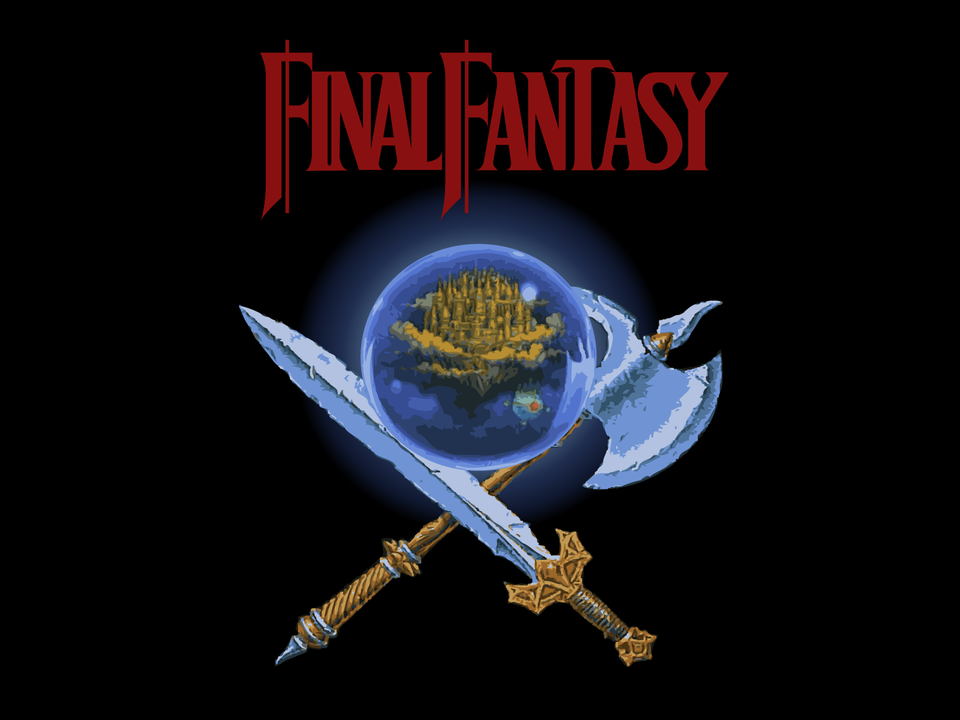
Now, I could have played the NES copy of Final Fantasy that I own, but unfortunately I left for vacation and won’t be back until January, when it’ll be time for Final Fantasy II. So, I used another version I had, the PSP remake. I do know of the changes, so I’ll try to discuss the original’s contributions more than the ones the remake introduced.
Fair warning, I had no way to get direct screenshots from my PSP, so I may have some ugly pictures. Sorry about that! Anyway, without further ado...
Story
“When darkness veils the world, four Warriors of Light shall come.”
Final Fantasy starts you off right away. No frills, no real story beyond some splash text about the world falling apart. Four young heroes, each with a crystal in their hands, show up in Cornelia one day, and before they know it they’re on a quest to save the world! Yes, it is that quick. The first game is extremely light on story, with cutscenes relegated to a few minutes at the absolute most. You make your four characters from six choices of class, and you’re tossed right into it.

The whole plot revolves around your four young heroes going to save the world. The light of the four elemental crystals is faded because of the four elemental Fiends. Because of this, the seas rage, the earth decays, the winds stop, and everything just generally sucks. It’s your job to defeat these monsters and restore light to the crystals so that everything can go back to normal.
Now, as you advance through the plot, things do end up getting a little more complicated. Without going into too many spoilers outside the spoiler section below, I must say that the story does go in a very surprising direction. I wasn’t around in 1987, but I can only imagine that it was positively shocking at the time. I was pleasantly surprised that they didn’t just go the obvious route.
Spoilers beyond this point!!! Skip this section if you don’t want to be spoiled!
I remember the first time I realized what was happening when I played this on my GBA seven years ago. The fact that everything was a closed time loop absolutely blew my mind then and it’s still impressive to me even now that they thought of it back in the late ‘80s. The loop is that you defeat Garland at the start of the game, and the four elemental Fiends send him back in time to hide and recuperate, allowing him to grow their power and send them out to take the Crystals’ light. Then two thousand years later, weak and old, he is attacked by four young heroes and wounded. You can guess what happens next.
Having to go back in time two thousand years to fight Garland at his most powerful shocked the hell out of me! In fact, this leads me to my next point: the story, while superficially simple, has a seriously bittersweet ending due to this twist. As you defeat Garland, who transforms into Chaos, you break the time loop that the game is locked in. When you return back to present time, nobody even knows your name. All the terrible struggles you went through to save the world are wiped clean. After all, you defeated Chaos two thousand years in the past; none of the problems the world faced originally have happened. So the four heroes wander and protect the land with nobody ever knowing their struggle.

That always stuck with me, as it’s not the picturesque sing-song happy ending most people expect in an RPG! After spending so much time with these characters, you want them to all ride off into the sunset. In Final Fantasy, that most certainly doesn't happen. However, I appreciate that Final Fantasy was willing to be more mature and not just hand you a perfect Disney ending. It’s even more impressive that they were bold enough to hit you with it in their very first outing.
Spoilers end here! You can continue reading!
With all that said, suffice to say that Final Fantasy’s story is simple with a few layers of mature complexity toward the end that’s a satisfying balance. It doesn’t shoehorn any filler in whatsoever, likely due to technical limitations. But because of that, it makes the final act of the game even more surprising. It’s not a perfect story or even a necessarily great one. However, it’s serviceable and at times breaks from tradition, which is almost always welcome.
Graphics
“With the crystal, even the blind can see.”
Let’s be honest here: Final Fantasy is a series known for having incredibly high production values. Square Enix likes to make sure each game looks cutting-edge and this first outing is no exception. One look at some of the NES version’s graphics will tell you that they really put their all into the designs of the characters, enemies and the world.
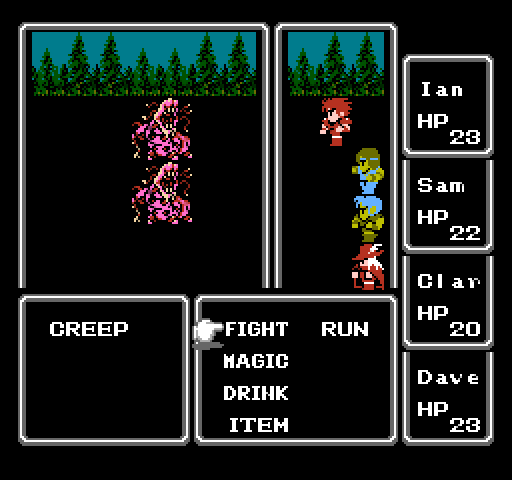
This applies to the PSP remake as well. Where the NES could only handle a paltry handful of colors and 8-bit designs, the PSP remake ensures that the original is updated and done justice. The character models are slick and colorful, the enemies are gorgeous and at times grotesque. Each sprite is lovingly redone to look the best that it can on the PSP, and it shows that a lot of care went into it.
But they couldn’t have remade those sprites without something to work with. The original Final Fantasy has some very unique designs for enemies that look great and push Nintendo’s console to the limit.
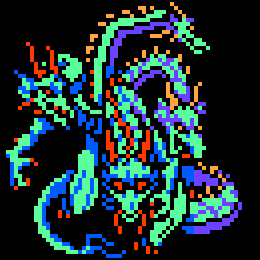
Now, as a result of the limited time, budget, and technology, the game falls victim to the palette swap tactic. This means that while there are unique enemies throughout, there are more powerful versions of previous enemies as well. They’re just colored differently, and despite that they still manage to have a healthy variety of good-looking enemies throughout. It’s slightly disappointing to see but understandable given the circumstances at the time of the game’s creation.

Overall, it’s safe to say that the game looks great. For a series that prides itself on looking the best that it can, the original Final Fantasy set the standard pretty high. Squaresoft wanted their title to shine bright among the other games on the NES. It's safe to say that what they managed to accomplish given the budget of a nearly bankrupt company is astounding.
Sound
“That sound? Nerrick is digging a canal.”
The music of Final Fantasy is one of the series’ most celebrated aspects. Naturally, it all had to start somewhere! One of those original seven team members at Squaresoft was a little known composer named Nobuo Uematsu. Maybe you’ve heard of him.
The original soundtrack for the game even today is exhilarating. Hearing the iconic prelude upon starting the game gave me some shivers, and the main theme of the series still hits me right in my nostalgia center when I hear it. The remake’s soundtrack redoes these tracks in glorious fashion, respecting the original compositions while updating them in just the right places to become an absolute treat for the ears. This is because Nobuo Uemastu himself updated the music. Who better to improve the music than the man who made the music originally?
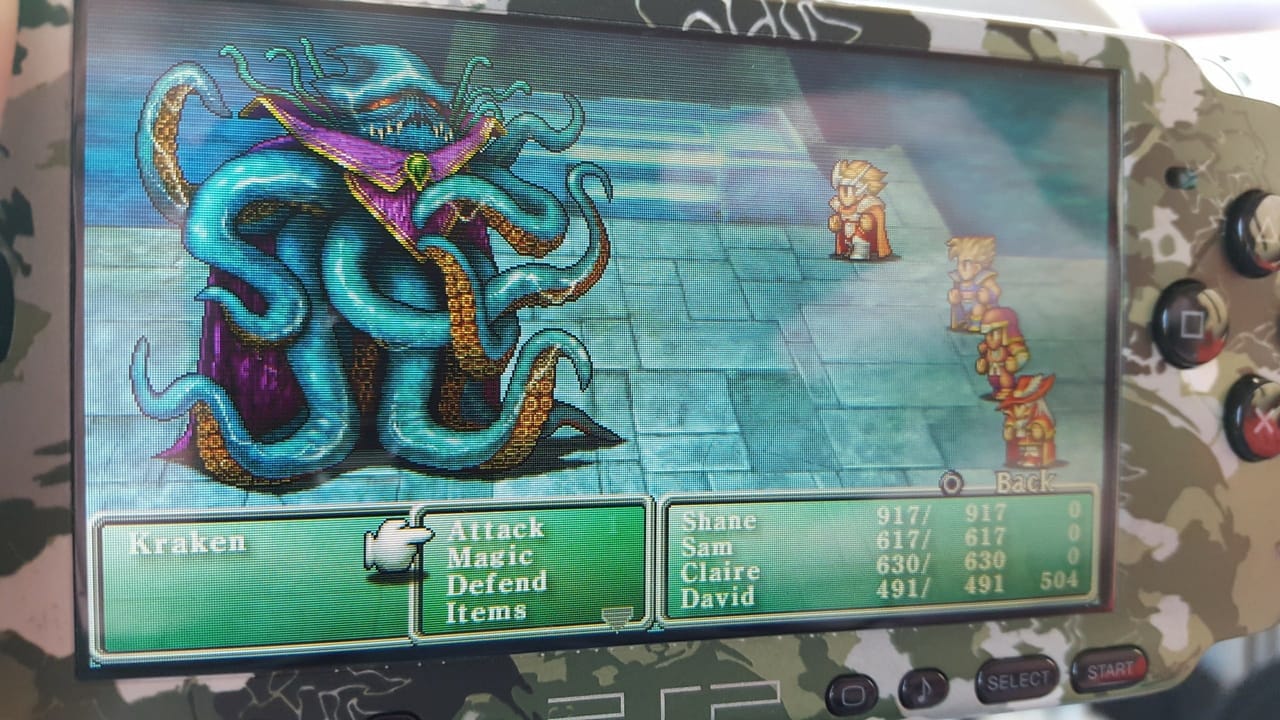
Some of the dungeon themes are great. I love the Mount Gulg and the Flying Fortress themes most of all, and the added tracks in the remake still fit the tone of the game great! Boss themes and a final boss theme weren’t in the original and were added in the WonderSwan version of the game. Of course, the remakes redo those songs as well to make them sound as good as they can. Needless to say, they fit great with the rest of the OST!
Overall, the sound of the game is fantastic as is expected from Nobuo Uematsu. You won’t be disappointed on this front!
Gameplay
“Only the courageous ones bring back the proof of their courage.”
So, what sort of gameplay can you expect from Squaresoft’s first foray into RPGs? As it turns out, it’s a game that’s quite different from RPGs of today in many respects.
When you start Final Fantasy, you get four warriors to mold as you see fit. There are six classes in total:
The Fighter/Warrior is your all-around tank. He wears the heavy armor, wields the heavy weapons and has a ton of health.
The Blackbelt/Monk is your glass cannon melee character. At the start, give him some nunchakus, and he’ll beat the snot out of enemies. However, he can’t wear heavy armor, so he’ll take a lot of damage too. A little secret though: after leveling him up a bit, try unequipping his weapons. Trust me, it’ll be like unleashing a whirlwind of deathpunches on your foolish foes!
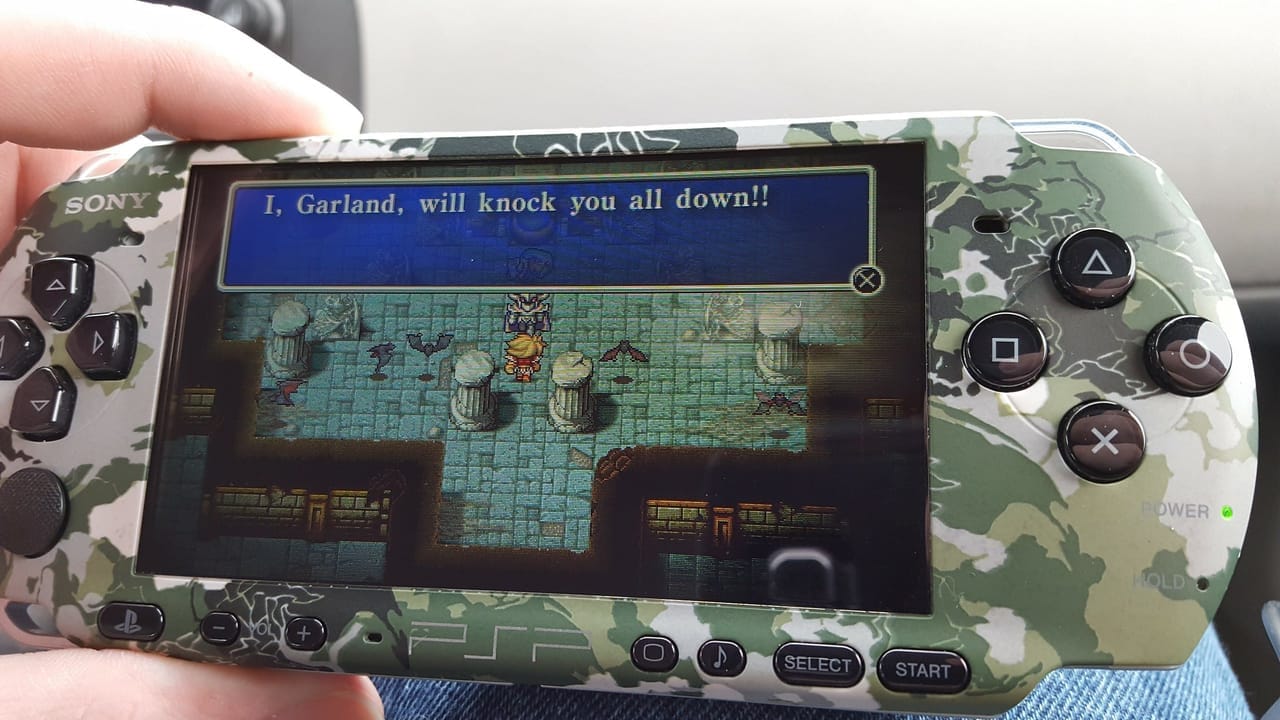
Next is the Thief. Despite the name, the Thief can’t do any item stealing. False advertising! What you get instead is a very nimble warrior that does decent damage and dodges a lot. The higher speed means the Thief will attack more times in a turn, doling out more damage.
The next three classes are all magic-based. The Black Mage dishes out pain, elemental damage and debuffs via powerful black magic. The White Mage, in contrast, buffs allies and heals damage and status effects with white magic. The Red Mage is jack of all trades, master of none; he can wield many decent weapons and armors as well as do plenty of black and white magic. However, he can never use the best stuff, like Flare (or in the NES version, the hilariously-named NUKE) or Full-Life. Or Excalibur even. For my playthrough, I chose a Warrior, Blackbelt, Thief, and Red Mage.
Magic is pretty interesting for the mages. There are seven magic levels with multiple black and white magic spells in each level. When you buy these spells, you equip them directly to the characters who will use them. However, you can only equip three spells from each level, and that’s it. With only a Red Mage, this made it extra difficult since I had to choose three spells for each level from two pools of potential spells.
It makes you think much more strategically. On top of that, the original game uses a spell system where you can only use a certain number of spells in a given level before you have to replenish via sleeping at an inn or tent. The remake does away with this and uses an MP system, but having played the NES original, I can say that it’s very different from games of today and quite traditional, drawing further parallels to Dungeons & Dragons.
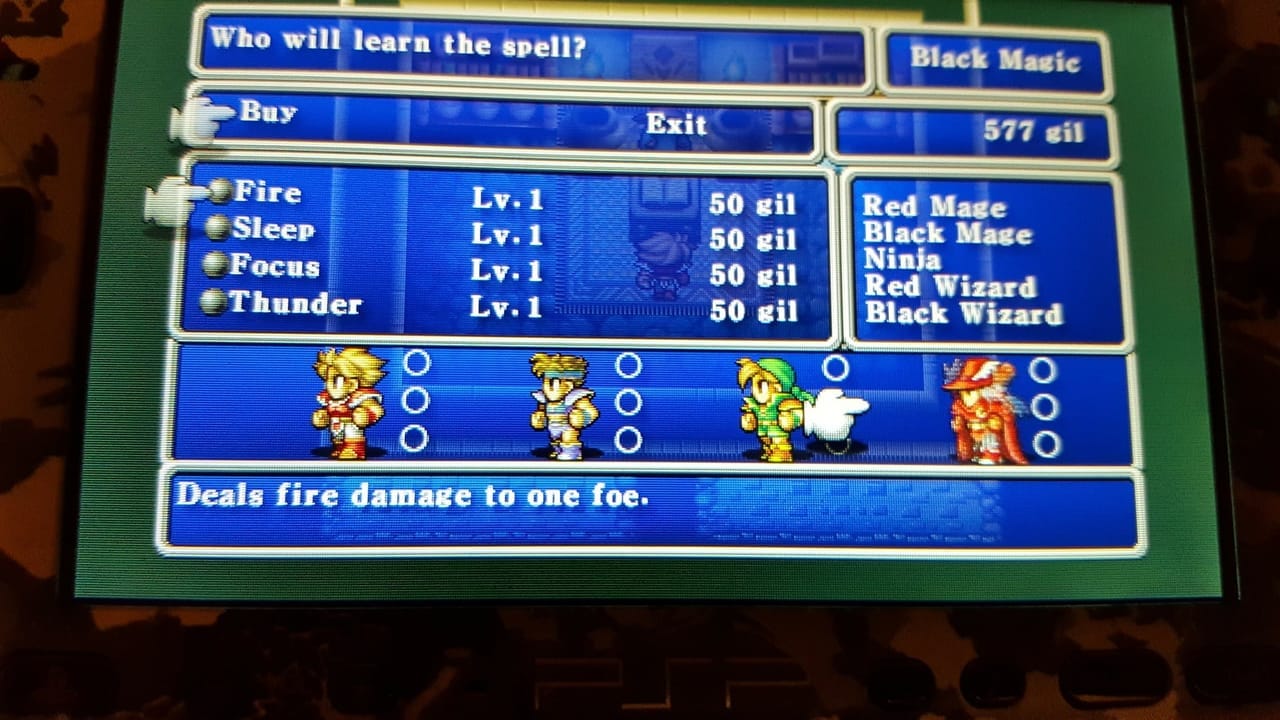
This proto-job system that will be expanded upon later in the series was already very cool when it first released. Taking inspiration from tabletop RPGs of the day, Final Fantasy made a great decision to allow you to build your own team. Also, by having more classes than characters means you have to play more than once to experience everything. Sounds crazy, right?
Well, it’s nowhere near as bad as you think. In my playthrough, I used absolutely no guides and only an extremely vague recollection of events from seven years ago on the GBA when I played. Even then, I have a clear file of 16 hours and 16 minutes. What?! That’s it?
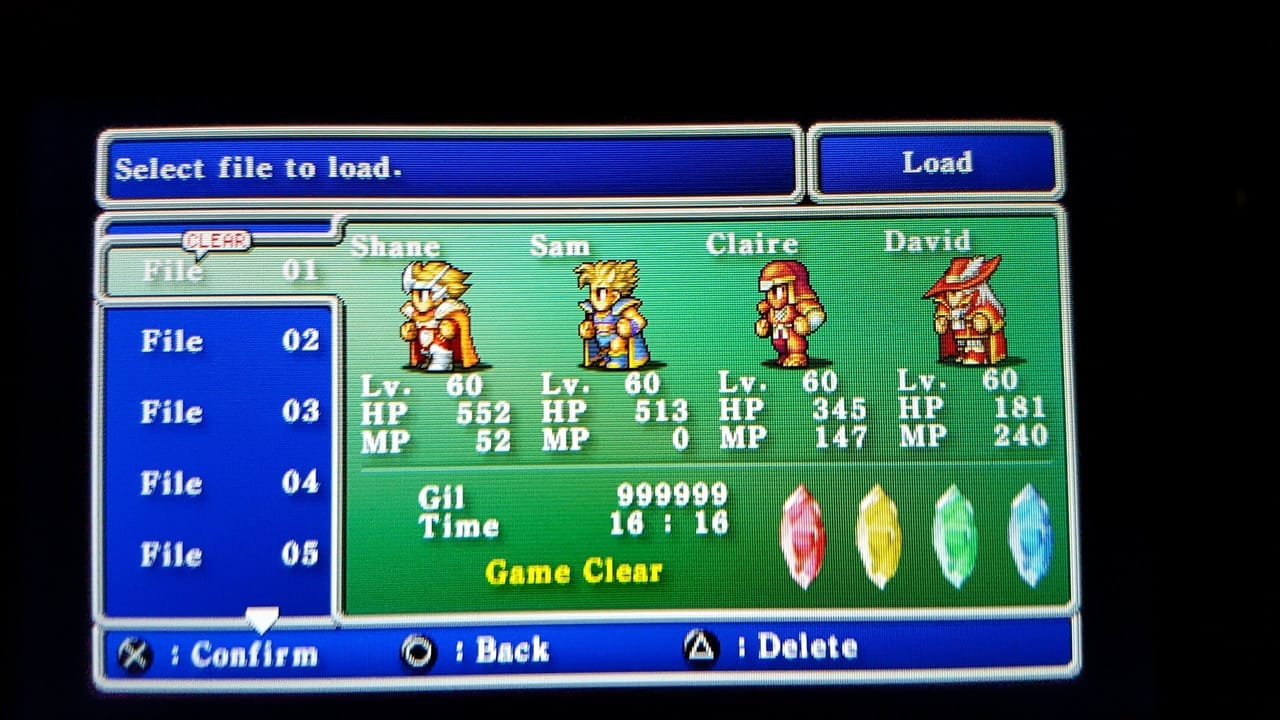
Yes, that is seriously it. Without doing any of the side dungeons and bonus content introduced in the remake and only doing what’s in the original title, the remake clocks in at an incredibly short game by today’s standards, let alone an RPG. Keep in mind, however, that this game came out in a time where 99% of titles were sidescrollers and platformers that could be beaten in the span of an hour or less. In that time, a 16 to 20-hour game was stunning.
However, the thing about that playtime is that the game is 100% gameplay. Like I said, there are very few cutscenes that I can think of during the game. Everything you do is initiated through dialogue, and there are no markers telling you where to go. The onus is on the player to explore, talk to townsfolk, and get clues for the next place to go. Once you do that, it’s then your responsibility to explore the map using those clues to discover your next point of interest. It’s a ton of freedom to the player that isn’t really seen much today, and it’s nice for a game to give the player some agency to find things on their own instead of putting a huge blinking arrow in their HUD.
This is both good and bad, as sometimes you can get lost easily. One time I was wandering the world map for an hour looking for where to go next. When I returned to the town I knew I was supposed to be at, I realized a hidden path in the corner leading to the guy I needed to talk to who gave me a key item. Oops!
Despite this, the game doesn’t overstay its welcome. I must admit, with the barebones, skeleton-level story the game has, stretching it out over 40 hours would be a nightmare for me. Cutting it to be a short, concise experience keeps it from getting monotonous while allowing enough time to get a chance to really enjoy the gameplay. This also feeds into the different jobs; with such a short playtime, it encourages players to replay the game with different team setups to get the full experience.
Suffice it to say, Final Fantasy maintains a healthy balance between playtime and gameplay. It’s a fun game with some unique twists on stuff like the magic formula. It gives the player enough to satisfy them, but it doesn’t try to add filler and stretch things out. When it’s ready to end, it ends. I sure wish some games today could take a page from this!
Extras/Replay Value
“If you are brave enough, try meeting the King of the Dragons, Bahamut.”
In sticking with the focus on the game and the main plot, Final Fantasy doesn’t have a ton of sidequests. That is, the original version of the game doesn’t. While technically an extra, it’s a great idea and almost required to promote your team. There’s a sidequest that involves a large castle of trials. You must enter once you have a Crown, then search for “proof of courage." Once you find it, you can hunt down the Dragon Caves and Bahamut himself. Upon seeing your proof, he will promote your units. Warrior becomes Knight, Monk becomes Master, Thief becomes Ninja, and the three mages become the Black, White, and Red Wizards. Each is able to use more weapons and higher level spells! On top of that, the Knight can learn up to Lv. 3 white magic and the Ninja can learn up to Lv. 4 black magic.
Like I mentioned, there are lots of cool bonus dungeons for those daring enough to brave them. The GBA version added the Soul of Chaos, which is the collective term for four bonus dungeons in the game. These are in the PSP remake as well as a fifth bonus dungeon exclusive to the PSP. The Labyrinth of Time is the hardest one yet!
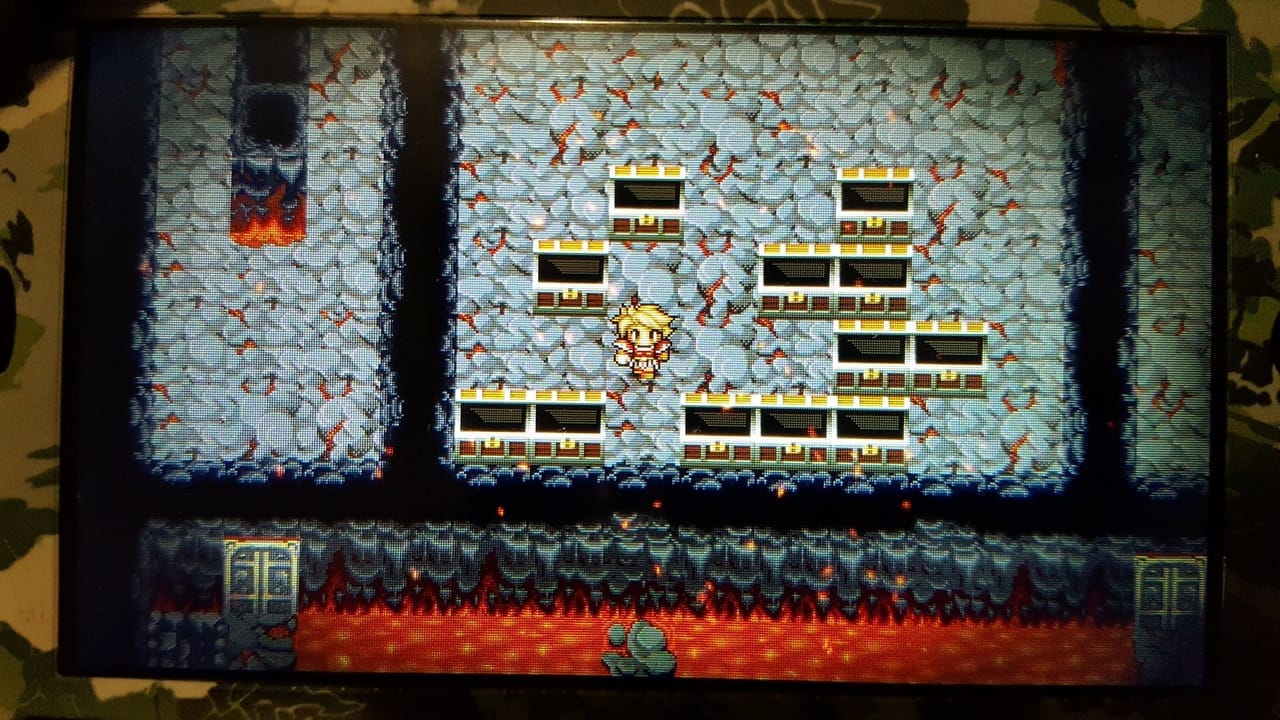
Each of the four elemental dungeons is progressively more difficult. Earthgift Shrine has five floors, Hellfire Chasm has ten. Lifespring Grotto has 20 floors and Whisperwind Cove has a staggering 40 floors! Each one has enemies from later games in the series and bosses from those games, ranging from Final Fantasy III to Final Fantasy VI. You can get really good loot from these dungeons, but the main thing you can get is bragging rights.
Now, the Labyrinth of Time is something different altogether. Where the Soul of Chaos dungeons are still your typical dungeons, the Labyrinth of Time is a decidedly non-traditional trek. Opening up right before the final dungeon, the Labyrinth of Time has you descending further and further down a long string of difficult puzzles and fights. It’s more than that, though; you must complete the floor’s task and escape before time runs out.
The thing is, you can choose how much time you get. Between each floor, you talk to a purple orb that gives you a list of options you can choose in exchange for time in the floor. These options range from “No Flee command," to “No recovery items," to even stuff like “No Fight command,” or no magic! There’s stuff like the inability to dash as well. Each one has a different time value attached to it, and each floor the number of options you can select changes, as well as which options are listed.
At the bottom of this hellish dungeon is Chronodia, the hardest superboss in Final Fantasy. Depending on if you completed the puzzles in time will determine Chronodia’s strength. Complete a bunch of them in time and Chronodia will be more powerful. Fail to complete these puzzles in time and Chronodia will be weaker. Sure, there’s incentive here to just fail all the time and make Chronodia weaker, but the true challenge is winning every floor and facing her at full strength.
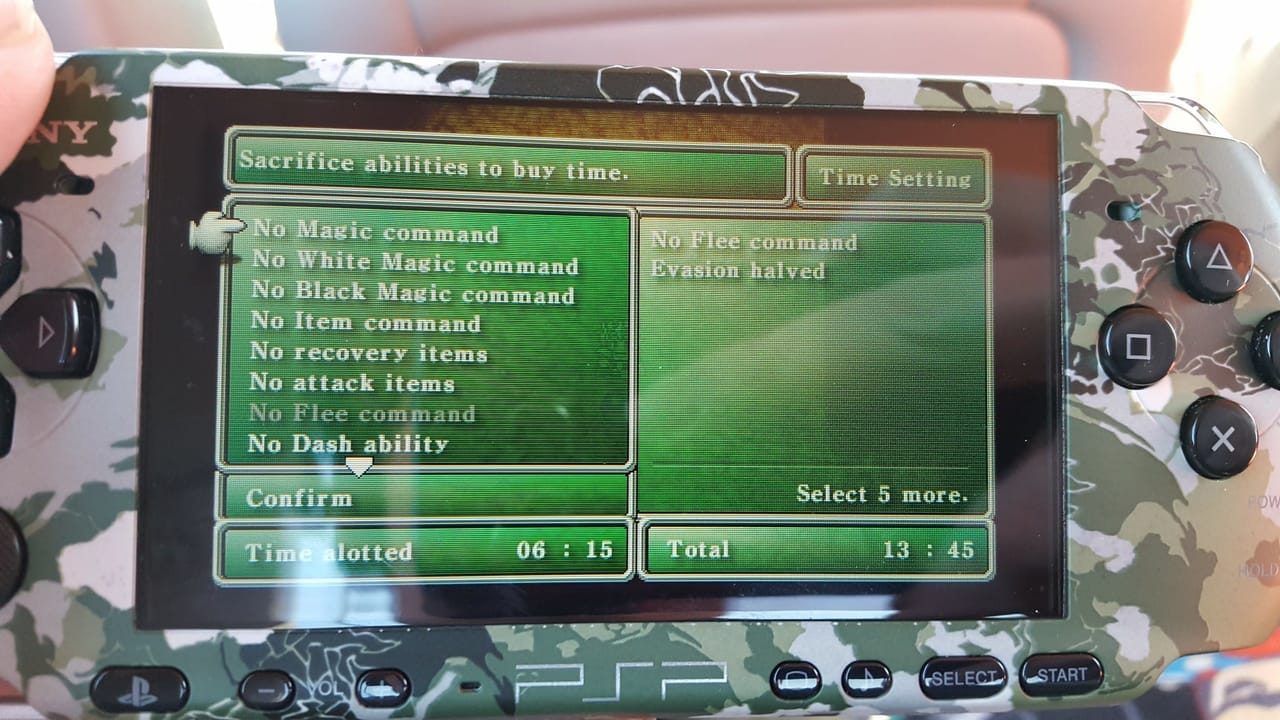
However, I do have a minor gripe with some of the cutscenes added in this version. When you beat a Fiend and light a Crystal, it plays a quick cutscene of the bonus dungeon associated with that Crystal unlocking. However, I didn’t remember much about the game so I assumed it was being helpful and pointing me forward. So, I went to Earthgift Shrine the first time and found myself actually trapped in the dungeon. You can’t exit until you die or beat it. So half an hour later, I finally died and was placed outside the dungeon instead of given a game over. No harm, no foul, fine.
Now I knew the next three times that those were bonus dungeons so I avoided them. However, when you enter the final area and are about to go into the final dungeon, a quick cutscene plays showing a hidden entrance in a certain place. Since this was different from the “beat dungeon, open bonus dungeon” cutscene, I assumed this was the entrance to the final area. However, it was the entrance to the Labyrinth of Time. I didn’t remember the game being so damn hard and being timed, so after three attempts of this I looked it up and realized I was beating my head against a wall for the past hour! Call me stupid, but needless to say I really feel like I wasted my time on that.
Anyway, long story short, the amount of side content in Final Fantasy depends on which version you play. It can either have a semi-optional sidequest in the earlier ones, all the way up to five big bonus dungeons in later releases. In a sense, you can choose exactly how much content you want. And like I said for replayability, the short nature of the game allows you to jump into it time and again with different team builds. With the almost complete lack of story, it makes getting into the game very easy.
The Final Word
Final Fantasy is a legend unto itself. The freshman attempt at RPGs is a timeless classic that manages to fit so much stuff into such a short span of time. It focuses on telling a story with some surprising twists but does so in such a way that it’s completely non-intrusive to the player. You know the basics, and the game allows you to fill in the blanks in your head. The gameplay, while simple, is still very satisfying.
The music, as you might expect, is downright fantastic. Nobuo Uematsu is a master of his class and to say otherwise is an insult. While the main story is very short, later releases of Final Fantasy have plenty of side content to keep you occupied. I must say, for a first foray, Final Fantasy shines bright. Even today, it stands as fun little RPG that I say all RPG fans should experience.
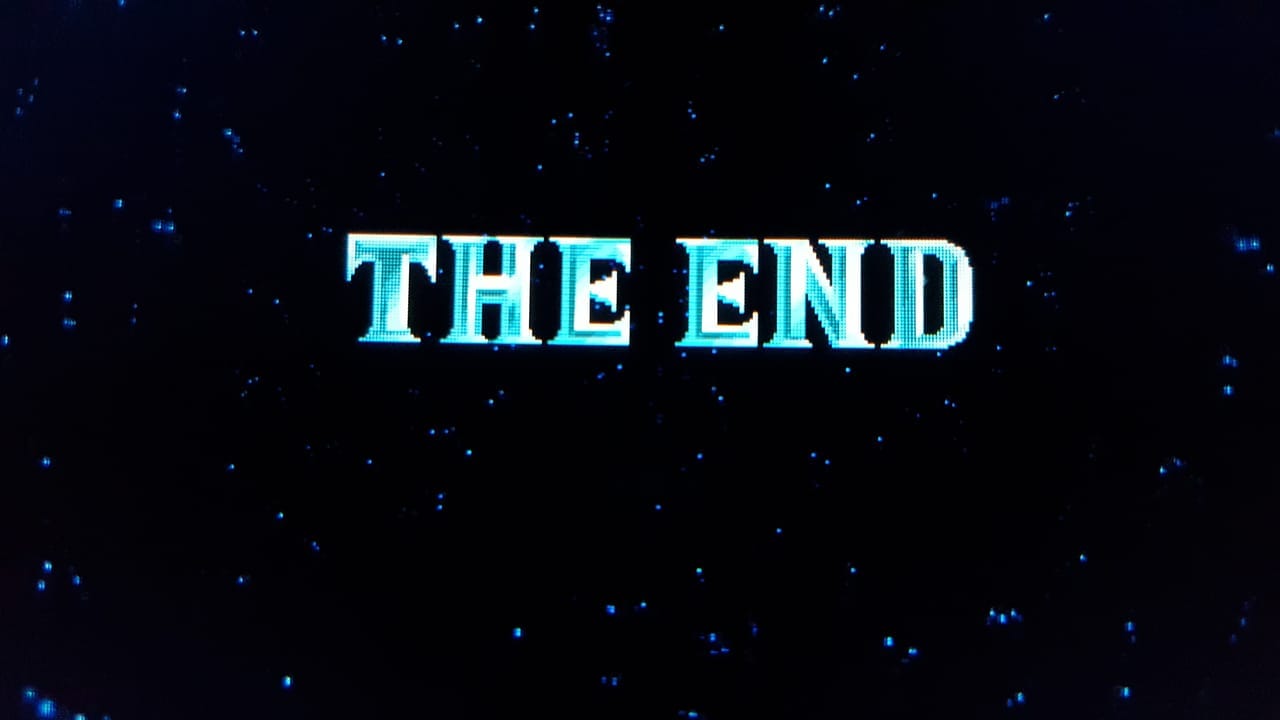
Have a tip, or want to point out something we missed? Leave a Comment or e-mail us at tips@techraptor.net
